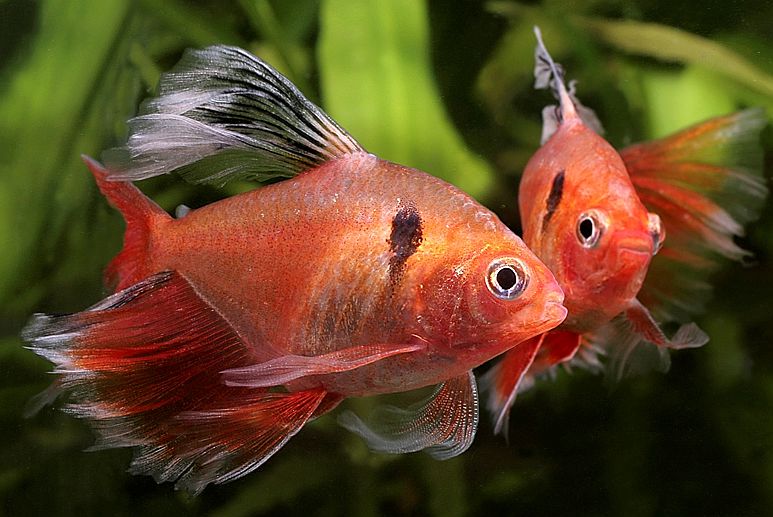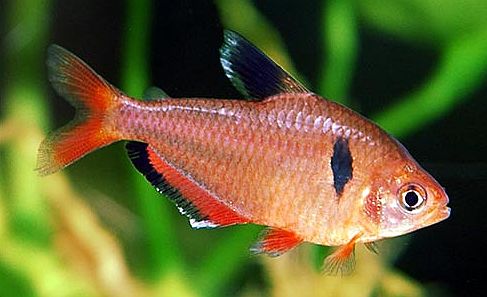The Serpae Tetra (Hyphessobrycon eques) is also commonly referred to as the Blood characin, Bloodtetra, Callistus tetra, Jewel tetra, Red minor tetra and Red serpae tetra by tropical fish keeping enthusiasts. The term “Blood tetra” is a generalization that is used to describe a wide range of red colored tetras sold by tropical fish shops.
The Serpae tetra has a tall, rather compressed body and a distinct red body color. The shades of red vary from bright red to reddish brown. A black comma shaped mark is located directly behind the gill cover in both sexes however, smaller and older specimens may have very small markings and sometimes no marking at all. The anal fins of Serpae Tetras are fringed with black and white layers that sometimes display a reddish hue, but the ventral and tail fins are always red. A long finned variety of Hyphessobrycon eques also exists.
Serpae Tetras are found in the Amazon river basin in South America, as well as the Guaporé and Paraguay rivers. They are an active semi aggressive shoaling species that in the wild are found close to the surface in calm, black, densely vegetated waters.
Serpae tetras are popular in community aquariums but should not be kept with smaller tetras or fancy guppies. They will do best in soft, neutral to slightly acidic water in groups of at least six fish.
Serpae Tetras need a large, densely planted aquarium with a dark substrate, driftwood or bogwood for shelter and hiding places, and plenty of room for swimming. Some floating plants
can be added to mimic the dimly lit conditions they prefer in their natural habitat.
Serpae Tetras are aggressive and competitive feeders. A school of Serpae tetras during feeding looks a lot like a school of Piranhas savaging their prey in a South American river.
In the wild, Serpae Tetras feed on worms, insects, crustaceans and plants. In an aquarium environment they will accept flake food, live, freeze dried, or frozen bloodworms, brine shrimp, tubifex, or daphnia. They need a varied diet to prevent malnutrition.
The Serpae Tetra is one of the easier tetras to breed. Place a conditioned pair in a small (5 gallon) aquarium with a dark substrate and lots of fine leaved plants such as Java Moss, Myriophyllum, or Cabomba. The pH should be between 6.0 to 7.0, the dH between 4 and 8, and the water temperature in the mid 70s. Filtering the water in the breeding tank through peat moss is also helpful.
Serpae Tetras are egg scatters and will deposit their tiny translucent eggs in the plants. As soon as the eggs are fertilized, remove the breeding pair to maximize the yield.
The eggs will hatch in 24 to 28 hours at which time the fry can be fed infusoria, egg yolk or baby brine shrimp. In a few weeks the fry can be fed finely crushed flake food or powdered flakes.
Minimum Tank Size: 10 gallons
Care Level: Easy
Temperament: Peaceful
Water Conditions: 72-82° F, KH 4-8, pH 5.0-7.8, dH 10 – 25
Max. Size: 1 1/2″
Color Form: Red
Diet: Omnivore
Compatibility: Semi-aggressive in small groups
Origin: Amazon River Basin
Family: Characidae
Life Span: 7 years
Aquarist Level: Beginner




